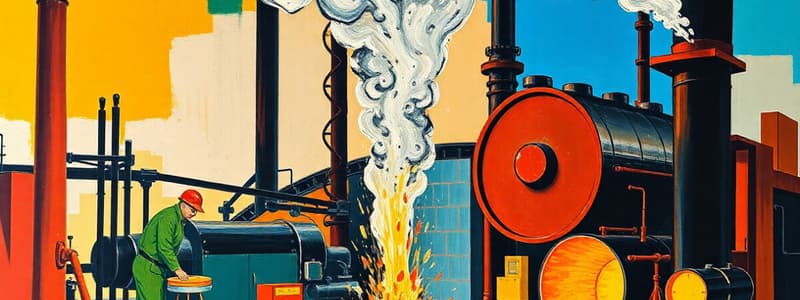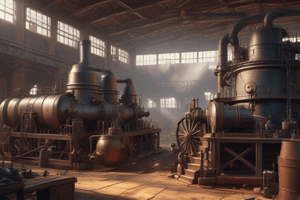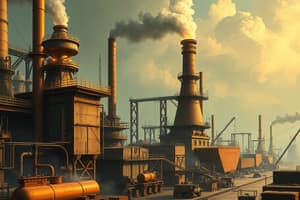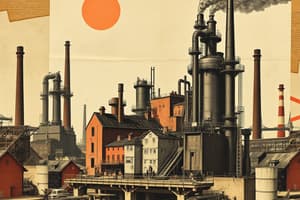Podcast
Questions and Answers
What was the most significant technological advancement that allowed for the mass production of steel during the Second Industrial Revolution?
What was the most significant technological advancement that allowed for the mass production of steel during the Second Industrial Revolution?
- Electric Arc Furnace
- Bessemer Process (correct)
- Open Hearth Method
- Crucible Steel Process
How did the Bessemer Process impact the labor force composition?
How did the Bessemer Process impact the labor force composition?
- Greater reliance on unskilled laborers (correct)
- Rise in artisan production methods
- Reduction in factory jobs overall
- Increased demand for skilled craftsmen
What was one effect of Frederick Taylor's principles of scientific management?
What was one effect of Frederick Taylor's principles of scientific management?
- Improved worker autonomy
- Increased complexities in production
- Enhanced safety regulations
- Streamlined efficiency in factory processes (correct)
What was a common reaction from workers to the implementation of scientific management principles?
What was a common reaction from workers to the implementation of scientific management principles?
What type of management structure began to emerge in large enterprises during the transformation of American manufacturing?
What type of management structure began to emerge in large enterprises during the transformation of American manufacturing?
Which of the following best describes the economic impact of the Second Industrial Revolution on American wages and wealth?
Which of the following best describes the economic impact of the Second Industrial Revolution on American wages and wealth?
What was a primary focus of managers utilizing scientific management methods?
What was a primary focus of managers utilizing scientific management methods?
What did Frederick Taylor believe about factory processes?
What did Frederick Taylor believe about factory processes?
What was a primary consequence of scientific management on the relationship between management and labor?
What was a primary consequence of scientific management on the relationship between management and labor?
How did corporations gain a competitive edge during the Gilded Age?
How did corporations gain a competitive edge during the Gilded Age?
What is horizontal integration in the context of corporate strategies?
What is horizontal integration in the context of corporate strategies?
What is the primary function of a trust in business organization?
What is the primary function of a trust in business organization?
What initial approach did the federal government take toward business practices?
What initial approach did the federal government take toward business practices?
What did the Interstate Commerce Act of 1887 specifically address?
What did the Interstate Commerce Act of 1887 specifically address?
What was a limitation of the Sherman Antitrust Act of 1890?
What was a limitation of the Sherman Antitrust Act of 1890?
Flashcards
Bessemer Process
Bessemer Process
A method for making steel more cheaply and in large quantities.
Second Industrial Revolution
Second Industrial Revolution
Shift from craft work to mass production in US.
Mass Production
Mass Production
Producing goods in large quantities.
Scientific Management
Scientific Management
Signup and view all the flashcards
Taylorism
Taylorism
Signup and view all the flashcards
Unskilled Labor
Unskilled Labor
Signup and view all the flashcards
Chain of Command
Chain of Command
Signup and view all the flashcards
Statistical Reporting
Statistical Reporting
Signup and view all the flashcards
Monopoly
Monopoly
Signup and view all the flashcards
Horizontal Integration
Horizontal Integration
Signup and view all the flashcards
Vertical Integration
Vertical Integration
Signup and view all the flashcards
Trust
Trust
Signup and view all the flashcards
Interstate Commerce Act
Interstate Commerce Act
Signup and view all the flashcards
Sherman Antitrust Act
Sherman Antitrust Act
Signup and view all the flashcards
Study Notes
Second Industrial Revolution
- Marked a shift from craft production to mass production in the US (1865-1900)
- Wages, wealth, capital, and GDP rose dramatically, outpacing global growth.
- Key figures like Edison, Bell, and Westinghouse contributed to advancements.
- Henry Bessemer's steel process (1855) was crucial for mass production & industrial mechanization.
Bessemer Steel Process
- Enabled the mass production of steel at lower costs.
- Led to significant changes in the workforce—more unskilled laborers in factories working machines.
Changing Management Styles
- Large enterprises adopted bureaucracies with clear hierarchies (starting with railroads).
- Frederick Taylor's scientific management aimed to improve worker efficiency.
Scientific Management
- Analyzed worker tasks to optimize their motions and productivity.
- Used stopwatches to measure efficiency, standardizing tasks.
- Provided tools and training to employees for maximum productivity.
- Compensation was tied to output, not time worked.
- Increased supervisor-to-worker ratio, leading to dehumanized labor.
- Caused tension between management and labor.
New Forms of Business Organization
- Corporations, already existing, gained power and influence during the Gilded Age.
- Pools: Informal agreements among companies to limit competition (e.g., setting prices).
- Horizontal Integration: Buying out competitors to eliminate rivals (monopolizing a market).
- Trusts: A group of companies formally controlled by a central board, streamlining management and giving control.
- Vertical Integration: Control over all aspects of production, from raw materials to retail. This eliminates middlemen and rivals.
Government's Response
- Initially, the government took a hands-off approach ('laissez-faire') to business.
- The Interstate Commerce Act (1887) and the Sherman Antitrust Act (1890) aimed to curb anti-competitive practices.
- The Sherman Act lacked a clear definition for "trusts" and had limited enforcement initially.
Studying That Suits You
Use AI to generate personalized quizzes and flashcards to suit your learning preferences.




